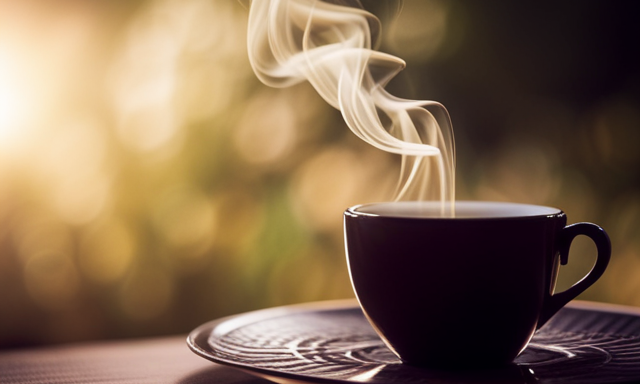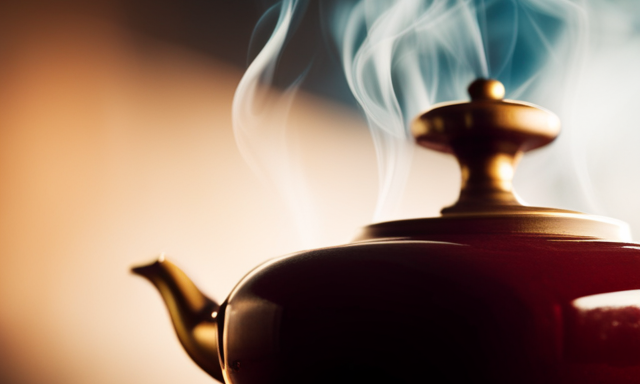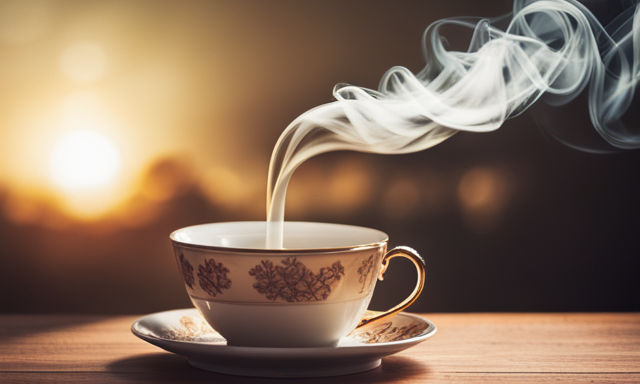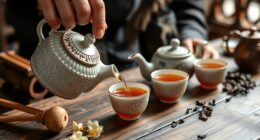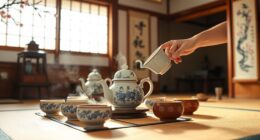As a tea enthusiast, I’ve always been fascinated by the diverse flavors that different types of tea offer. And when it comes to oolong tea, the flavor is truly a delight for the senses. Oolong tea, with its unique taste profile, sits perfectly between green and black tea, offering a balanced and complex flavor that is both floral and fruity.
The alluring aroma and smooth, mellow taste make oolong tea a favorite among tea connoisseurs.
In this article, we will explore the origins of oolong tea and delve into the intricate process of making it. We will also uncover the health benefits associated with oolong tea and discover how it pairs harmoniously with various types of food. Additionally, we will dive into the rich traditions and culture surrounding oolong tea, as well as the sustainable and ethical practices employed in its production.
So, join me on this flavorful journey as we unravel the captivating world of oolong tea.
Key Takeaways
- Oolong tea has a complex and multi-dimensional flavor profile with hints of fruit, flowers, and honey.
- Different varieties of oolong tea offer distinct taste experiences, including floral, roasted, or honey flavors.
- The production process of oolong tea involves a delicate balance of oxidation and heat to achieve desired flavors.
- Oolong tea pairs well with a variety of foods, including sushi and desserts, and its high antioxidant content makes it a healthier choice with sweet treats.
Origins of Oolong Tea
Oolong tea, with its rich and distinctive flavor, has a fascinating history that dates back to its origins in China. The origins of oolong tea can be traced back to the Fujian province of China, where it was first discovered and cultivated.
This semi-oxidized tea is known for its unique combination of the qualities of green and black tea. It undergoes a special process of withering, rolling, and oxidizing, which gives it a complex flavor profile.
Oolong tea is renowned for its health benefits, including boosting metabolism, aiding in digestion, and promoting heart health. Its unique flavor profile, with notes of floral, fruity, and toasty flavors, sets it apart from other types of tea.
This makes oolong tea a truly special and versatile beverage.
The Unique Flavor Profile of Oolong Tea
With its distinctive blend of floral and toasty notes, this traditional Chinese brew offers an enchanting taste experience that captivates tea connoisseurs worldwide. Oolong tea’s flavor profile is complex and multi-dimensional, making it a delight to explore. Its taste characteristics can vary depending on the specific type of oolong and the processing methods used. Generally, oolong tea has a smooth and mellow taste with hints of fruit, flowers, and honey. Some varieties may exhibit a creamy or buttery texture, while others may have a more roasted or nutty flavor. The table below showcases some common flavor profiles found in different types of oolong tea:
| Oolong Type | Flavor Profile |
|---|---|
| Tie Guan Yin | Floral, sweet, and silky |
| Da Hong Pao | Roasted, mineral, and earthy |
| Oriental Beauty | Honey, fruity, and complex |
These taste characteristics make oolong tea a truly unique and enjoyable beverage. Moving on to the subsequent section about different varieties of oolong tea, we will further explore the diverse range of flavors that this tea has to offer.
Different Varieties of Oolong Tea
When you explore the world of oolong tea, you’ll be amazed at the diverse range of flavors that await you, like a treasure chest full of hidden gems just waiting to be discovered.
Oolong tea comes in various varieties, each with its own unique flavor profile. From the delicate floral notes of the green oolong to the rich and roasted flavors of the dark oolong, there is something to suit every palate.
Some oolong teas have a creamy texture and a hint of sweetness, while others offer a more earthy and nutty taste. No matter which variety you choose, oolong tea is known for its complex, multidimensional flavors that linger on your tongue.
Now, let’s dive into the intriguing process of making oolong tea.
The Process of Making Oolong Tea
Indulge yourself in the captivating artistry behind crafting a perfect cup of oolong tea. Embark on a journey through the intricate process that yields its mesmerizing aroma and taste.
The process of making oolong tea involves a delicate balance of oxidation and heat. First, the leaves are plucked from the Camellia sinensis plant and withered under the sun. Then, they undergo a partial oxidation process that is carefully controlled to ensure the desired flavor profile.
The leaves are then gently rolled, promoting further oxidation. After this, heat is applied to halt the oxidation process and lock in the flavors. The role of heat is crucial in oolong tea production as it determines the final taste and aroma.
The result is a tea that boasts a complex and captivating flavor, with notes of fruit, flowers, and honey.
As we delve into the health benefits of oolong tea, you’ll discover even more reasons to incorporate this delightful beverage into your daily routine.
Health Benefits of Oolong Tea
Experience the multitude of health benefits that oolong tea brings to your daily routine. From boosting metabolism to promoting heart health and aiding digestion, oolong tea has it all.
Oolong tea is renowned for its ability to support weight loss. The combination of catechins, caffeine, and polyphenols in oolong tea helps to increase metabolism, allowing your body to burn calories more efficiently.
Additionally, oolong tea has been shown to lower cholesterol levels and reduce the risk of heart disease. The antioxidants in oolong tea help to prevent the oxidation of LDL cholesterol, which can lead to plaque buildup in the arteries. Incorporating oolong tea into your diet can have a positive impact on your overall cardiovascular health.
Transitioning into the subsequent section about the best ways to brew and enjoy oolong tea, you’ll discover the perfect methods to fully savor its rich flavor and embrace its healthful properties.
Best Ways to Brew and Enjoy Oolong Tea
Embrace the art of brewing and savoring oolong tea by exploring the various methods that allow you to fully appreciate its delicate aromas and nuanced flavors. The brewing process is crucial in unlocking oolong tea’s true potential. Here are some tips to help you brew and enjoy oolong tea like a pro:
-
Start with the best oolong tea brands: Look for reputable brands that source high-quality leaves to ensure a flavorful experience.
-
Experiment with different water temperatures: Oolong tea can be brewed using hot water ranging from 180°F to 212°F, depending on the desired taste. Lighter oolongs typically require lower temperatures, while darker oolongs benefit from hotter water.
-
Use proper steeping times: Steep oolong tea for 2-4 minutes to extract the ideal balance of flavor and aroma.
By following these oolong tea tasting tips, you can elevate your tea-drinking experience to new heights.
Now, let’s transition into the subsequent section about pairing oolong tea with food.
Pairing Oolong Tea with Food
Enhance your culinary journey by discovering the perfect food pairings that complement the unique characteristics of oolong tea.
For example, imagine savoring a light, floral oolong tea alongside a delicate piece of sushi, where the tea’s subtle notes enhance the overall dining experience.
Oolong tea is not only a wonderful beverage on its own, but it also pairs exceptionally well with desserts. The rich, complex flavors of oolong tea can perfectly balance the sweetness of desserts like creamy cheesecake or fruity tarts. This pairing creates a harmonious blend of flavors that tantalize the taste buds and leave you craving for more.
Moreover, the benefits of drinking oolong tea, such as its high antioxidant content and potential weight management properties, make it an even more appealing choice when enjoying a sweet treat.
As we explore oolong tea traditions and culture, we’ll delve deeper into its fascinating history and rituals.
Oolong Tea Traditions and Culture
When it comes to oolong tea, it’s not just about the amazing flavor and its ability to pair well with food. There is a rich cultural heritage associated with this tea that has been passed down through generations. Oolong tea ceremonies are an integral part of Chinese culture, where the preparation and serving of the tea is considered an art form. These ceremonies are steeped in tradition and are a way to honor the tea and its history.
In addition to its cultural significance, oolong tea has also made its mark in literature. From ancient Chinese texts to modern novels, oolong tea is often mentioned, symbolizing elegance, sophistication, and spiritual enlightenment.
As we delve into the world of oolong tea, it’s important to also consider the sustainability and ethical practices in its production. It’s fascinating how the cultivation and processing of this tea have evolved over time to meet the demands of a conscious and environmentally aware consumer.
Sustainability and Ethical Practices in Oolong Tea Production
Sustainability and ethical practices are at the forefront of oolong tea production. This ensures that every sip you take supports a conscious and environmentally aware industry. To achieve this, sustainable farming techniques are employed. These techniques minimize the use of pesticides and promote ecological balance.
Fair trade practices are also crucial in oolong tea production. These practices guarantee that farmers are fairly compensated for their work, creating a more equitable supply chain.
When you imagine oolong tea production, envision lush tea plantations nestled amidst rolling hills. Here, farmers carefully hand-pick tea leaves, preserving the delicate flavors. This picture showcases the harmonious coexistence of humans and nature. Farmers work in harmony with the environment, protecting biodiversity and conserving resources.
With these sustainable and ethical practices, every cup of oolong tea becomes a testament to the dedication and passion of the tea producers.
Now, let’s explore where to buy and find oolong tea.
Where to Buy and Find Oolong Tea
Immerse yourself in the world of oolong tea by exploring various online retailers and local tea shops, where you can readily discover a wide selection of this exquisite beverage. When it comes to buying oolong tea, you have the option of purchasing it online or visiting a local tea shop. Buying online offers convenience and the ability to browse through a wide range of options from the comfort of your own home. Some popular online retailers for oolong tea include TeaVivre, Adagio Tea, and Harney & Sons. On the other hand, visiting a local tea shop allows you to interact with knowledgeable staff who can guide you in selecting the perfect oolong tea based on your preferences. Moreover, you may have the opportunity to sample different varieties before making your purchase. Local tea shops such as David’s Tea, Teavana, and Argo Tea often carry a diverse selection of oolong teas, ensuring you find the flavor and aroma that suits your taste buds. So whether you choose to buy oolong tea online or visit a local tea shop, the world of oolong tea is just a few clicks or steps away.
| Online Retailers | Local Tea Shops |
|---|---|
| TeaVivre | David’s Tea |
| Adagio Tea | Teavana |
| Harney & Sons | Argo Tea |
Frequently Asked Questions
Are there any side effects of drinking oolong tea?
There are minimal side effects of drinking oolong tea, making it a healthy choice. It offers numerous health benefits, such as aiding in weight loss, lowering cholesterol levels, and improving heart health.
How much caffeine does oolong tea contain compared to other types of tea?
Oolong tea has a moderate caffeine content compared to other types of tea. It offers numerous health benefits such as boosting metabolism, aiding digestion, and promoting heart health.
Can oolong tea help with weight loss?
Oolong tea is believed to be an effective weight loss aid due to its role in boosting metabolism. However, it’s important to note that while it may help, it is not a magic solution and should be combined with a healthy diet and exercise.
What is the recommended daily intake of oolong tea for maximum health benefits?
For maximum health benefits, I recommend consuming 2-3 cups of oolong tea daily. This golden elixir, with its myriad of health benefits, is like a gentle breeze that revitalizes the body and nourishes the soul.
Does oolong tea have any impact on blood sugar levels?
Oolong tea can potentially impact blood sugar levels. It is known for its potential antioxidant properties and may aid in weight management. However, the flavor of oolong tea is not relevant to this discussion.
Conclusion
What flavor is oolong tea?
Oolong tea is known for its complex and nuanced flavor profile. It falls somewhere between green tea and black tea, offering a unique taste that is both floral and fruity. The flavor can vary depending on the specific type of oolong tea and how it is processed. Some oolong teas have a delicate and light flavor, with notes of orchid or honeysuckle. Others have a more robust and full-bodied taste, with hints of stone fruit or roasted nuts. The level of oxidation also plays a role in the flavor, with lightly oxidized oolong teas having a fresher and greener taste, while heavily oxidized ones tend to be richer and more earthy. Overall, oolong tea is a truly captivating beverage that delights the palate with its complexity and depth of flavor.

